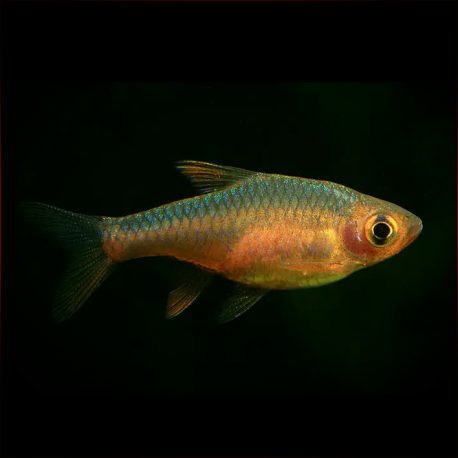More info
Datasheet
| Minimum Tank Size | 60 litres / 15.85 US gallons |
| Maximum Size | 4.0cm / 1.57inches |
| Temperature | 23°C / 73.40°F - 27°C / 80.60°F |
| Hardness | 1.01dgH / 18ppm - 8.01dgH / 143ppm |
| pH | 5.5-7.0 |
General Description
The Rasboroides Vaterifloris, commonly known as the Fire Rasbora, is a delicate species that may also be found under the names of 'pearly rasbora', 'vateria flower rasbora', 'orange-finned barb', or 'Singhalese fire barb'. It displays a range of colors depending on its locality, with red, orange, and yellow-finned forms documented. The body color can vary from red or orange to bluish tones. This species is not frequently encountered in the aquarium trade due to challenges in commercial production and shipping issues.
Aquarium Setup
For setting up an aquarium suitable for the Fire Rasbora, it is recommended to provide a heavily planted tank with a dark substrate, floating plants, driftwood, branches, and leaf litter to mimic its natural habitat. A gentle filtration system is advisable, as the species is accustomed to sluggish waters and may struggle in strong currents. Acclimatization to aquarium life is crucial, and regular water changes of around 10% tank volume are essential for maintenance.
Behaviour
The Fire Rasbora tends to be shy and is not well-suited for community tanks with aggressive or larger tankmates. This species thrives in small groups of at least 6-10 individuals, as they are schooling fish by nature. Maintaining them in such numbers reduces skittishness, enhances color development in males, and creates a more natural display in the aquarium.
Feeding and Diet
In its natural habitat, the Fire Rasbora primarily feeds on invertebrates and organic detritus. In an aquarium setting, they readily accept a diet of small live and frozen foods like bloodworms, Daphnia, and Artemia, along with high-quality dried flakes and granules. Regular feeding is crucial to maintain their optimal condition and vibrant colors.
Reproduction & Dimorphism
The Fire Rasbora is an egg-scattering species that exhibits no parental care. To encourage breeding, a dedicated breeding tank with plants for egg deposition and gentle filtration is recommended. Adult males are smaller, slimmer, and more colorful compared to females, especially during spawning. The fry require delicate care and a gradual transition to larger food items as they grow.
Habitat and Distribution
Endemic to southwestern Sri Lanka, the Fire Rasbora is found in the Kalu, Bentota, Gin, and Nilwala river basins in the island's wet zone. Unfortunately, the species faces habitat degradation due to deforestation and human activities, leading to a decline in water quality and threatening various native fish species with extinction. The remaining forests are fragmented and house a diverse range of flora and fauna endemic to the region.

